 |
A Visual Pilgrimage to Pir-e
Sabz, near Yazd, Iran
Varza, Jamshid
To Zoroastrians of Iran this
place is their holiest one; they take their annual pilgrimage to Pir-e
Sabz "the green saint" at the beginning of summer. |
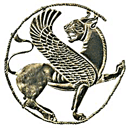 |
Achaemenian Jewel Arts
Varza, Jamshid |
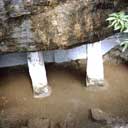 |
Bharot Caves- A case for preserving historical sites
Varza, Jamshid |
 |
Fire Temple at ancient city of "Ragha" Ray, near
Tehran
Varza, Jamshid
Is this magnificent historic
site the heart of ancient city of Ragha, mentioned in Avesta and other
ancient Persian texts? Pay a virtual visit to this magnificent ancient
fire temple. |
 |
Firuzabad -- A
Sassanian Palace or Fire Temple?
Varza, Jamshid
Is this the site a Royal
Palace built by Ardeshir, the founder of the Sassanian Dynasty, or is it the
site of a Fire Temple?
Take a visual tour of this magnificent site, learn about its history and
figure out the answer to this ancient riddle |
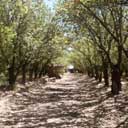 |
Lasting Legacy of the Just King
Soroushian, Dr. Mehrborzin
Ancient Iran drawing on the
teachings of Zarathushtra, had a special emphasis on agriculture and a
settled way of life. In its attempt to interest the warring Arab tribes
to take greater interest in farming, a Sassanian king moves members of a
warring Arab tribe to a village in the Kerman province to acquaint
them with agricultural skills. A pictorial tour of this ancient village
is presented. |
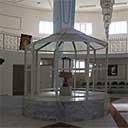 |
Legacy of Kerman's Gabr-Mahalla
Soroushian, Dr. Mehrborzin
Zarathushti housing quarters in Iranian cities like Kerman and Yazd in
Iran were known as Gabr-Mahalla -- Zarathushti neighborhood. Residents
viewed them as their sanctuary but very much open to intrusion. Each
Gabr-Mahalla has a rich and telling history. This essay will tell a
brief history of Gabr-Mahalla of Kerman. |
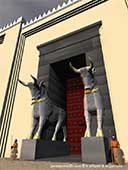 |
Magnificence of Persepolis Virtual Reconstruction
Afhami, Kourosh
The magnificent palace of
Persepolis serving as the site of world's first super power, under the Achaemenians,
was unique in its architectural design bringing together the best design
ideas from far corners of the empire. This visual reconstruction gives
the viewer a better sense of the grandeur of that palace. |
 |
Novrooz in Persepolis
Varza, Jamshid |
 |
Palace of Darius in Biblical city of Susa, in south
western Iran
Varza, Jamshid
The ancient city of Susa has
been well known for its importance from pre-historic times till this date.
It has been the site of biblical prophet Daniel's tomb, and capital of Elamite
kingdom.
Above all, Susa was the southern capital of the Persian Empire, and
favorite city of Darius the Great. In this essay we visit the ruins of
Darius magnificent palace in Susa. |
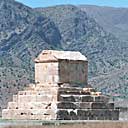 |
Passargadae,
the birthplace of Persian Empire
Varza, Jamshid
The Old
Testament, Herodotus writings, and archeological findings all describe
Cyrus the Great as a figure of immense importance in ancient history.
Cyrus founded the Persian Empire, the first ancient world empire
consisting of many nations, cultures and religions based on his own
Zoroastrian belief in equality of all men. |
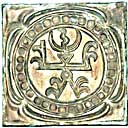 |
Sassanian Plaster Art
Varza, Jamshid |
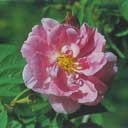 |
The legendary Rose of Iran
Kerr, Dr. Sam
The legendary Rose of Iran and its exquisite
fragrance have been admired for millennia. The Rose had been nominated as
‘The National Treasure of Persia’ long before any other nation deemed a
rose a National Flower Emblem. It continues to capture the imagination of poets and intellectuals. |
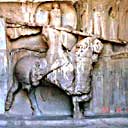 |
Taq-e-Bustan
--
A magnificent Sassanian site in north western Iran
Varza, Jamshid
Roman general
Ammianus Marcellinus
gives an account of Sassanian armed soldiers riding horses and the horrifying
scene they created for their enemies. Find out more about this
important historic site in northwest Iran.
|
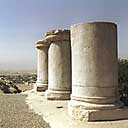 |
Temple of Anahita at Kangavar
Varza, Jamshid
In small town of Kangavar one
sees ruins of historic site known today as temple of Anahita.
Achaemenian emperor, Ardeshir-II, built this palace on a major east-west
road in his empire. |
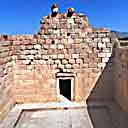 |
Temple of Anahita at Bishapur
Varza, Jamshid
Shapur I,
Sassanian Emperor's victory over Valerian brought over seventy thousand
Romans to Persia. The fire temple next to Shapur's palace was built by
a group of Roman prisoners of war... |
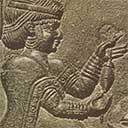 |
The ancient art of spinning a yarn
Kerr, Dr. Sam
Hand-spinning of animal fur
fiber to produce a single or double ply yarn was an art excelled in by
women in the Eastern Classical World from times of remote antiquity, long,
long before the initial hand-cranked ‘Spinning Wheel’ was first introduced
in Europe during medieval times. Elamite rock bas-reliefs c. 6000 BCE show
the delicate procedure being executed and Sumerian clay tablets c. 4000
BCE talk about it in details. It is of interest that Zarathushti women in
Iran and on the Subcontinent have pursued this exquisite art of
hand-spinning to the 21st century. |
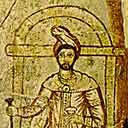 |
The Earliest Image of Prophet Zarathushtra
Varza, Jamshid
|
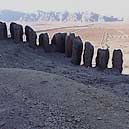 |
The Last War Dakhma of Iran
Soroushian, Dr. Mehrborzin
Afghan’s
attack on Kerman on 1721AD brought catastrophe to Zarathushti farmers
living in villages in the region. Facing this massacre, survivors had to
quickly create a make shift dakhma. Remnants of this site still stand on
the road from Kerman to Mashad. |
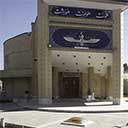 |
The New Fire Temple of Kerman
Soroushian, Dr. Mehrborzin
Legacy of fire temples dates
back to early Indo-Iranian migration periods, and was later adapted into
the Zoroastrian religion. The new fire temple of Kerman, built close to
an older temple, has its own unique character captured in this visual
essay. |
 |
The Sumerian ‘Tree of Life’
Kerr, Dr. Sam
A
Sumerian clay tablet dating back to 2500 BCE captures the Indo-Iranian
concept of the origin of human life evolving from plant life - a concept
promoted in the Zoroastrian texts. A brief narrative is included. |
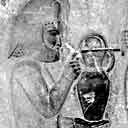 |
Tribute bearers of Persepolis
Varza, Jamshid
Persepolis, the ceremonial
capital of the Persian Empire holds magnificent carvings on its stone
gates, stairways and interior walls. Images of Tribute bearers lead by a
Mede or Persian nobleman can be seen in several places. "Who were the
Tribute bearers?" is the question I attempt to answer in this issue of
Visual Essays. |
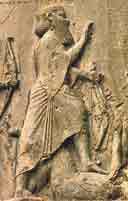 |
Words
of Darius in Behistun and Mehregan Festival
Varza, Jamshid
In Behistun, world's largest
rock relief and inscription, Darius the Great gives his account of his
triumphs. See images of this magnificent ancient inscription and details
of its decipherment.
A festival of great importance to Persians known as Mehregan or Mithrakana was
considered ancient when Achaemenian kings
celebrated it. It was during this festival that Darius identies Gaumata, the false Smerdis and destroys him,
thus saving the
Empire. Smerdis, or Bardya, was the second of son of Cyrus
the Great who was going to succeed Cambyses.
|